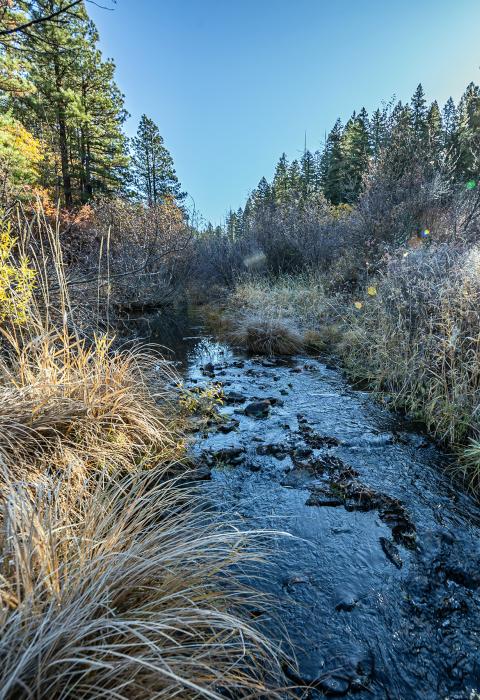Jenny Creek
Oregon
Flowing through the Cascade-Siskiyou National Monument, Soda Mountain Wilderness, and private lands, Jenny Creek is an exemplary mountain stream. From its headwaters, Jenny Creek traverses the rolling mountains, plateaus, and canyons of southwest Oregon where it joins the Klamath River in far northern California.
Situated at the apex of the Klamath, Cascade, and western Great Basin ecological provinces, this is a region of exceptionally high biodiversity and beauty. In addition to the floristic diversity, Jenny Creek hosts several endemic fish species and is home to a rich diversity of wildlife. Scenic vistas of the distant mountains and valleys of the southern Cascade mountain range beckon visitors to linger just a little while longer at this unique wild and scenic river.
Bureau of Land Management (BLM) administrative studies from the 1990's determined that Jenny Creek was eligible for wild and scenic river designation, with outstandingly remarkable fish and historic values (ORVs) identified. In 2019, the John D. Dingell Jr. Conservation, Management and Recreation Act designated 7.3 miles of the creek to be managed by the U.S. Department of Interior. Following designation, ORVs were identified in the Congressional Record as fish, wildlife, history, recreation, scenery, and ecology/biological diversity.
Designated Reach
March 12, 2019. From the Bureau of Land Management boundary located at the north boundary of the southwest quarter of the southwest quarter of T 38 S, R 4 E, Section 34, Willamette Meridian, downstream to the Oregon State border.
Outstandingly Remarkable Values
Preliminary Finding
Ecology/Biological Diversity
The Jenny Creek watershed has perhaps the greatest biodiversity of any area in all of Oregon. The area comprises the geographic convergence of the Klamath, Cascade, and western Great Basin floristic provinces. This diversity is represented in the range of available habitats and landscape processes which occur here. The watershed has over a dozen conifer and sixteen species of hardwood trees. Several BLM special status and federally listed fish, wildlife, mollusk, and plant species are found within the area. Stands of mature and old-growth forest remain scattered throughout the watershed. Wet meadows, seeps, cliffs, and springs add to the landscape diversity.
Preliminary Finding
Fish
Fifteen species of native and introduced fish are found in the Jenny Creek watershed. Populations of the endemic Jenny Creek sucker and redband trout have been geographically isolated from the Klamath River by the two major waterfalls located on the lower creek.
Preliminary Finding
History
The Jenny Creek watershed is an unusually rich area for historic and cultural resources. Evidence of human occupancy dates to over 6,000 years ago. The modern history of western settlement is also evident across the landscape, including a portion of the Applegate Trail that was created in 1846 as an alternate route to the Willamette Valley from the Oregon Trail. In 1992, a section of the Applegate Trail that passes through the river corridor, was added to the California National Historic Trail.
Preliminary Finding
Recreation
Jenny Creek provides a wide variety of dispersed outdoor recreation activities, including hunting, fishing, camping, hiking, kayaking, viewing scenery, or simply exploring the creek. The creek also provides an exceptional trout fishery.
Preliminary Finding
Scenery
Jenny Creek consists of a variety of diverse landforms and topographic features, including high plateaus, creekside meadows, forested mountain slopes, and distant views of the valleys and volcanoes of the southern Cascade mountains. Two high waterfalls add to the scenic diversity of the rugged lower canyon.
Preliminary Finding
Wildlife
Jenny Creek provides high-quality habitat for several sensitive or federally listed species, including northern spotted owl and northwestern pond turtle. The southern end of the watershed is designated as critical winter range for deer and elk. Wild horses may even be encountered. This watershed also hosts a variety of reptiles and amphibian species which do not commonly occur within the Cascade mountains province.

